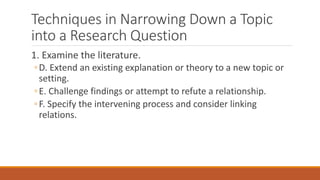Lesson 5 writing a research title
- 2. What is a RESEARCH TITLE? A research title is a product of real world observations, dilemmas, wide reading, selective viewing, films documentaries and deep reflection. The title of the research is the research problem in capsule form. It must clearly reflect the topic of investigation and it must be original, clear, concise or specific.
- 3. Example of Broad Topics Blended Learning in English Class Presidential Election Results Agri-business Social networking Vegetarianism
- 4. Example of Specific Topics A correlation study in the use of blended learning in Freshman English Classes and student achievement.
- 5. Techniques in Narrowing Down a Topic into a Research Question 1. Examine the literature. ◦ Published articles are an excellent source of ideas for research questions. They are usually at an appropriate level of specificity and suggest research questions that focus on the following: ◦ A. Replicate a previous study project exactly or with slight variations. ◦ B. Explore unexpected findings discovered in previous research. ◦ C. Follow suggestions an author gives for future research at the end of an article.
- 6. Techniques in Narrowing Down a Topic into a Research Question 1. Examine the literature. ◦D. Extend an existing explanation or theory to a new topic or setting. ◦E. Challenge findings or attempt to refute a relationship. ◦F. Specify the intervening process and consider linking relations.
- 7. Techniques in Narrowing Down a Topic into a Research Question 2. Talk over ideas with others. A. Ask people who are knowledgeable about the topic for questions about it that they have thought of. B. Seek out those who hold opinions that differ from yours on the topic and discuss possible research questions with them.
- 8. Techniques in Narrowing Down a Topic into a Research Question 3. Apply to a specific context. A. Focus the topic on a specific historical period or time period. B. Narrow the topic to a specific society or geographic unit. C. Consider which subgroups or categories of people/units are involved and whether there are differences among them.
- 9. Techniques in Narrowing Down a Topic into a Research Question 4. Define the aim or desired outcome of the study. A. Will the research question be for an exploratory, explanatory or descriptive study? B. Will the study involve applied or basic research?
- 10. Choosing a Topic for a Research Study In choosing a research topic, it is important to select a topic that interest and motivates you. It should be “doable” with the resources at your disposal and within the required time frame. The research topic should be focused and well-defined.









